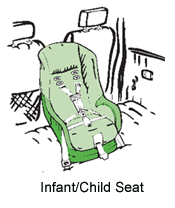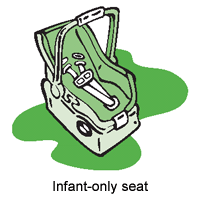|
Car Time
|
 |
|
TP 14337E
ISBN 0-662-39337-6
Cat. T46-29/1-2005E
March 2005 |
|
|
|
Babies have weak neck and back muscles that need extra support when traveling in a vehicle. A
rear-facing infant seat will support your baby’s head and neck in a sudden stop or a crash. Be sure
you use a rear-facing infant seat that fits your baby’s weight and height. Use it correctly in the rear-facing position, in the back seat, every time
your baby rides in the car.
Rear-facing infant seats are available as infant- only seats, infant/child seats, or infant/child/ booster
seats.
|

|
 |
An infant-only seat is designed only for use as a rear-facing infant seat.
An infant/child seat or an infant/child/booster seat can be used as a rear-facing infant seat. Later,
these seats can be used as forward-facing child seats when it is the right time to have the child ride facing the front of the vehicle. See
Car Time – Stage 2 for more information about forward facing child seats.
Rear-facing infant seats have different upper weight limits. Check the label on the rear-facing
infant seat for the weight and height that are allowed by the manufacturer. |
|
|

|
Don’t be in a hurry to start using a forward-facing child seat. The longer you use a
rear-facing infant-only seat, infant /child seat, or infant/child/booster seat
that fits correctly, even past your baby’s first birthday, the safer your baby will be in a crash.
Be sure to follow the manufacturer’s instructions for use and check the label for the
weight and height that are allowed.
|
|
| Installing a rear-facing infant seat
|
- Read the car seat instructions and the vehicle owner’s manual to learn how to install a
rear facing infant seat in your vehicle.
- Always put a rear-facing infant seat in the back seat of the vehicle.
- Never put a rear-facing infant seat in the front passenger seat.
- If your vehicle has side air bags, see the Transport Canada fact sheet on
How to
Protect Children in Vehicles with Side Air Bags.
- Put the handle of the infant-only seat in the position recommended by the manufacturer.
|
|
Installing with UAS |
- Car seats manufactured after September 1, 2002 have two UAS
connectors that attach to the UAS anchor bars in newer vehicles.
- Check the vehicle owner’s manual for the seating positions that
can be used with UAS.
- You may need to thread the UAS webbing strap through the
infant/child seat or the base of the infant-only seat.
- Attach the two UAS connectors to the UAS anchor bars and tighten the
strap.
- The rear-facing infant seat should not move more than 2.5 cm (1
inch) from side to side or forward.
|
|

|
Items not provided by the car seat manufacturer such as liners, trays,
or comfort straps may interfere with the safety of the seat. Check with the car seat manufacturer
before using these products with the baby’s car seat.
|
|
Installing with a seat belt
- Thread the seat belt webbing through the path as shown in the infant seat instructions.
- Buckle the seat belt and make sure it is tight. The seat belt keeps your baby’s seat in place in
the vehicle.
- The rear-facing infant seat should not move more than 2.5 cm (1
inch) from side to side or forward.
|
 |
With some vehicles, you will need to use a locking clip with the seat
belt to hold a rear-facing infant seat securely in place. Read the vehicle instructions for installing
children’s car seats. |
 |
Using the infant seat outside the vehicle
Some infant seats are also used to hold or carry a baby outside the vehicle. Make sure you keep
the harness fastened correctly whenever your baby is in the seat.
- Do not use the infant seat if your baby is bigger than the height or weight printed on the
label.
- When you use an infant seat outside the vehicle, the seat can tip over easily when the
baby moves.
- Place the infant seat on or close to the floor.
- Make sure nothing will fall on your baby.
- Never leave your baby unattended.
|
 |
The use of an infant car seat as a crib outside the vehicle has
resulted in death when the infant became tangled in the straps and strangled. An infant
car seat should never be used as a crib. |
|
When to replace a rear-facing infant seat
- If there was a crash and the rear-facing infant seat was in the car at the time. You should do
this even if your baby was not riding in the seat during the crash.
- When the car seat has reached the expiry date.
- If there is no expiry date, replace a seat that is ten years old.
Fill out and mail the registration card that comes with your child’s car seat. If there is a recall, the
company will be able to contact you.
|
|
|
|
Top
Contact Us:
For questions about your car seat, please contact the manufacturer. For more information or to order more copies of this publication,
contact:
Transport Canada at:
1-800-333-0371, by email: roadsafetywebmail@tc.gc.ca
Health Canada at:
(613) 952-1014, by fax: (613) 941-4376 or by email: cps-spc@hc-sc.gc.ca
Top
You can also download "Car Time - Stage 1: Safe Travel in a Rear-facing Infant Seat" (PDF
format, 383 Kb).
To view PDF documents you must use Adobe® Acrobat Reader. Visit the
Adobe site to download the latest, free version.
If you need an alternative format or for more information, please contact us by e-mail at
RoadSafetyWebMail@tc.gc.ca
or call toll free 1-800-333-0371 (Ottawa area (613) 998-8616).
|

